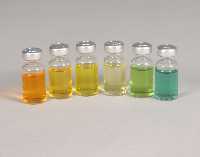
Carotenoids and Chlorophylls
- Pigment standards derived primarily from phytoplankton
- Ready-to-use HPLC grade standards with the concentrations provided
- Especially applicable in calibration of instruments, e.g., HPLC
- Shipped in dry ice all over the world
- Certificate-of-Analysis shows the concentration and the HPLC chromatogram
The chloro pigments are dissolved in 90% acetone and most of the carotenoids are in 100% ethanol except aphanizophyll, astaxanthin, capsaxanthin, α-carotene, α-cryptoxanthin, bacteriochlorophyll a, β-carotene, β-cryptoxanthin, dinoxanthin, lycopene, mutatoxanthin and myxoxanthophyll, which are all in 100% acetone.
The pigment standards are supplied in sealed vials of 2.5 ml and contain a nitrogen atmosphere. When stored frozen (below -20 °C), the pigments are stable for at least three years. The standards should, however, be used immediately after breaking the seal. Certificates-of-Analysis specifying concentrations, stability, storage and handling accompany the standards when shipped in dry ice.

The concentration most often ranges between 0.4 and 1.7 mg/L (the specific concentration is given on the Certificate-of-Analysis).
Furthermore, a chlorophyll a standard with a higher concentration (approx. 4 mg/L) is also available.
More information on the determination of the concentrations of the individual pigments.
Terms of delivery: Prices are exclusive of shipping costs. Please note that dry ice consignments are more expensive than ordinary shipping (approx. 226 EUR to EU countries, approx. 337 EUR to US mainland, Japan, Taiwan, and South Korea. Other countries: please enquire a shipping price).
The following pigment standards are available:
| Alloxanthin |
Chlorophyll a * |
Divinyl chlorophyll a
|
Mutatoxanthin |
α-carotene
|
Chlorophyllide a
|
Divinyl chlorophyll b
|
Myxoxanthophyll
|
α-cryptoxanthin
|
Chlorophyllide b
|
Echinenone
|
Neoxanthin
|
Antheraxanthin
|
Chlorophyll b
|
Fucoxanthin
|
Peridinin
|
Aphanizophyll
|
Chlorophyll c1
|
Gyroxanthin-diester
|
Pheophorbide a
|
Astaxanthin
|
Chlorophyll c2
|
19'-hexanoyloxyfucoxanthin
|
Pheophytin a
|
Bacteriochlorophyll a
|
Chlorophyll c2-MGDG
|
19'-hex-4-ketofucoxanthin
|
Prasinoxanthin
|
β-carotene
|
Chlorophyll c3
|
4-keto-myxoxanthophyll
|
Violaxanthin
|
β-cryptoxanthin
|
Crocoxanthin
|
Lutein
|
Zeaxanthin
|
19’-butanoyloxyfucoxanthin
|
Diadinoxanthin
|
Lycopene
|
|
Canthaxanthin
|
Diatoxanthin
|
Monadoxanthin
|
|
Capsanthin
|
Dinoxanthin
|
Mg-DVP
|
|
* two different concentrations available to choose from
For prices please see our pricelist